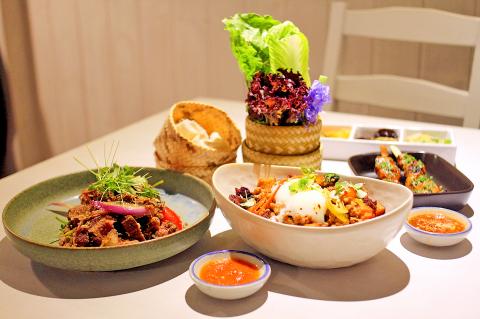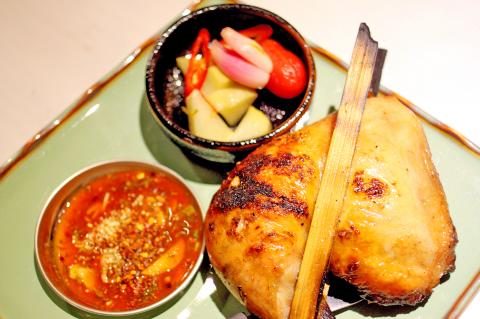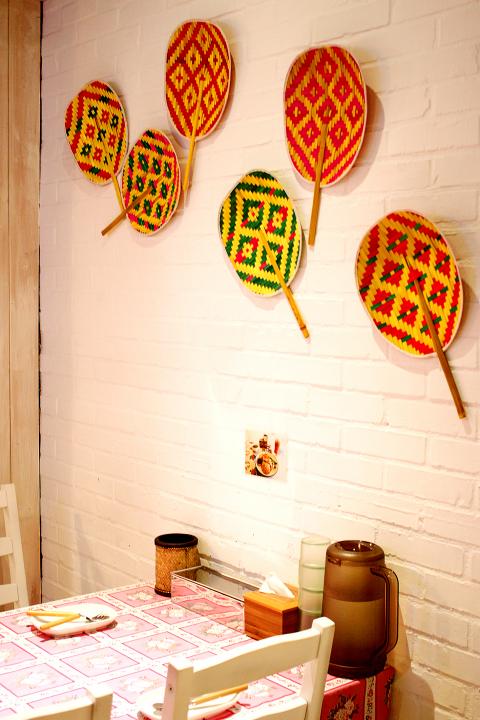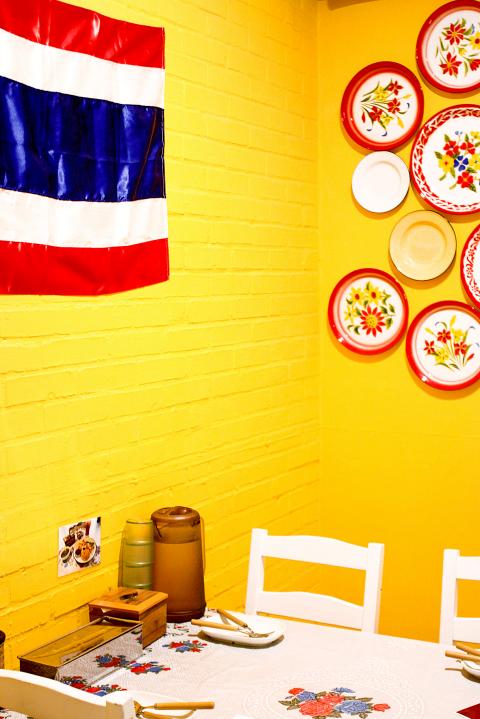Calvin Wang (汪義諠) has worked in some of Taipei’s best fine-dining kitchens, from French institution Joel Robuchon to the avant-garde Gen Creative. But for his first independent venture, the young chef, a self-described “third culture kid,” looked back to the comforts of his childhood in Bangkok.
Kao Jai Thai Bistro, his brainchild, opened this summer a couple of paces away from Breeze Center, adding to the many mid-market dining options in the area. Tables at the casual dining space span two floors, with an additional bar on the ground level and spacious private room in the basement.
The interior is lovingly decorated with artifacts hauled back from Thailand, from ornate PVC tablecloths to flowery enamelware, bamboo baskets and a portrait of the late Thai king. The decor may be homey and familiar, but the food is decidedly not.

Photo: Davina Tham, Taipei Times
You won’t find tom yum, green curry or pad Thai here. It’s obvious that Kao Jai isn’t interested in satisfying these tried-and-tested takeout cravings, which are all that some ever sample of Thai food. Instead, the menu distills chef Calvin’s experiments with new flavor and texture combinations that push at the boundaries of the Thai culinary realm.
Take the duck larb (NT$450) for example. Larb, a meat salad with fresh herbs, is commonly eaten in the Isan region of Thailand, bordering Laos, where it’s considered a national dish. Here, fresh mint, a kicker tamarind dressing and sweet-sour cherry tomatoes add layers of flavor that are discernibly Thai. But when the usual ground meat is swapped out for succulent chunks of duck, served slightly warm, that tips the dish over into newer territory.
If you eat pork offal, the nam tok (NT$420), or pork neck with pig’s liver and ears, will be irresistible. Perennial favorite som tam, or papaya salad, is also available, with betel nut leaves and salted egg (NT$250). But the emphasis is undoubtedly on grills and wok stir-fries.

Photo: Davina Tham, Taipei Times
Moo ping pork (NT$180) on skewers is well-executed, but pales in comparison to the superlative grilled chicken (NT$340). A whole thigh with charred skin and appetizingly pink, juicy meat is served with nam jim jaew, a spicy-sour dipping sauce.
Kao Jai puts a lot of thought into such accents. Every table gets a trio of pickles — guava, black fungus and radish, when I visited — as well as a bouquet of salad leaves and a fist-sized round of sticky rice to supplement the dishes with acidity and crunch, or mellow them out as needed.
Aside from the nam jim jaew, a Thai lime pesto and caramelized pineapple sauce can also go with other grills, like the beef tongue (NT$480) and chicken satay (NT$180). The fermented chili deepens heat and umami in just about anything you add it to.

Photo: Davina Tham, Taipei Times
A note about spice levels: the kitchen keeps the heat mild by default, to suit local palates, so tell the waitstaff if you don’t want them to hold back. I didn’t get the message across in time for my stir-fried ground pork with holy basil (NT$260), dialed up a notch by the addition of deeply caramelized sweet potatoes and a soft-boiled egg, and felt that it could do with more salt and heat.
I was also expecting punchier and aromatic notes in the Thai fried rice (NT$160), but the flavors here were muddled. The addition of a soft-boiled egg also seemed a bit overzealous, especially since it made the rice grains soggy.
Thai beer (NT$100) is the ideal accompaniment to this meal. The full menu is only available at night, but if you find yourself in the area on a weekday afternoon, Kao Jai also serves a business set of chicken rice (NT$220) with seasonal vegetables, pickles, egg and an iced Thai milk tea. It’s tender, healthful and filling.

Photo: Davina Tham, Taipei Times
Kao Jai hasn’t perfected its execution yet, but the newfangled dishes I’ve tried so far keep me hopeful that chef Calvin keeps thinking outside the box. Given the popularity of Southeast Asian cuisines here, it’s about time that one-of-a-kind Thai cooking found its way to Taipei.

Many people noticed the flood of pro-China propaganda across a number of venues in recent weeks that looks like a coordinated assault on US Taiwan policy. It does look like an effort intended to influence the US before the meeting between US President Donald Trump and Chinese dictator Xi Jinping (習近平) over the weekend. Jennifer Kavanagh’s piece in the New York Times in September appears to be the opening strike of the current campaign. She followed up last week in the Lowy Interpreter, blaming the US for causing the PRC to escalate in the Philippines and Taiwan, saying that as

US President Donald Trump may have hoped for an impromptu talk with his old friend Kim Jong-un during a recent trip to Asia, but analysts say the increasingly emboldened North Korean despot had few good reasons to join the photo-op. Trump sent repeated overtures to Kim during his barnstorming tour of Asia, saying he was “100 percent” open to a meeting and even bucking decades of US policy by conceding that North Korea was “sort of a nuclear power.” But Pyongyang kept mum on the invitation, instead firing off missiles and sending its foreign minister to Russia and Belarus, with whom it

The Chinese Communist Party (CCP) has a dystopian, radical and dangerous conception of itself. Few are aware of this very fundamental difference between how they view power and how the rest of the world does. Even those of us who have lived in China sometimes fall back into the trap of viewing it through the lens of the power relationships common throughout the rest of the world, instead of understanding the CCP as it conceives of itself. Broadly speaking, the concepts of the people, race, culture, civilization, nation, government and religion are separate, though often overlapping and intertwined. A government

Nov. 3 to Nov. 9 In 1925, 18-year-old Huang Chin-chuan (黃金川) penned the following words: “When will the day of women’s equal rights arrive, so that my talents won’t drift away in the eastern stream?” These were the closing lines to her poem “Female Student” (女學生), which expressed her unwillingness to be confined to traditional female roles and her desire to study and explore the world. Born to a wealthy family on Nov. 5, 1907, Huang was able to study in Japan — a rare privilege for women in her time — and even made a name for herself in the